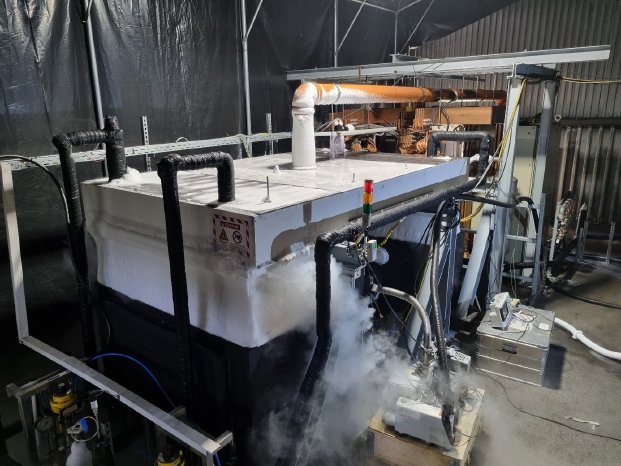under the leadership of Vision Electric Super Conductors (VESC).
In the preceding project, “3S,” industrial feasibility for a 20,000 A superconducting system was demonstrated in BASF’s chlorine electrolysis. The goal of Demo200 was to increase the current to the operating current of Trimet’s aluminum smelter of 180,000 A or higher.
Superconductors are materials that conduct electricity without resistance and electrical losses once they are cooled to operating temperature. This project used ceramic high-temperature
superconductors from Theva, which operate at 77 Kelvin (approx. -196 °C) in boiling nitrogen.
An Innovative Superconducting Busbar System for Aluminum Production
At the end of July, the demonstrator of the newly developed superconducting busbar was delivered to the Trimet aluminum plant in Voerde. In this facility, aluminum is produced from aluminum oxide ("alumina") using a high-current electrochemical process ("electrolysis").
The demonstrator consists of two current leads and a superconducting busbar in between, which is extremely compact with a diameter of less than 30 cm. "The operation of the current leads with the superconducting busbar is a real milestone" explains CEO Dr Wolfgang Reiser from VESC. "We did not only achieve a current of 180,000 A, but we were even able to increase it to 190,000 A- a globally unique success in applied superconductivity."
Setting the Course for Future Applications
Following the Demo200 project, the superconducting busbar system is to be used on an even larger scale. The corresponding follow-up project "SuprAl" is already in planning. As part of this project, a 600 m long superconducting busbar is to be laid parallel to an existing aluminum busbar, reducing the current transmission losses by around 90%.
Pioneering Prospects for the Industry
The use of superconductors for such high currents opens up new possibilities for using this technology in various high-current applications - from metal production to energy transmission.
"Superconductors have the potential to transfer large amounts of energy without the
disadvantages of conventional conductors," adds Wolfgang Reiser.
Further information on superconductors and their possible applications can be found on the websites www.vesc-superbar.de, www.demo200.de and www.ivsupra.de.



